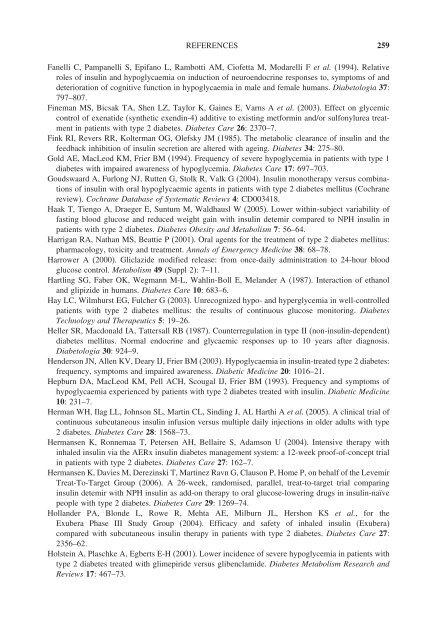Hypoglycaemia in Clinical Diabetes
Hypoglycaemia in Clinical Diabetes
Hypoglycaemia in Clinical Diabetes
- No tags were found...
Create successful ePaper yourself
Turn your PDF publications into a flip-book with our unique Google optimized e-Paper software.
REFERENCES 259Fanelli C, Pampanelli S, Epifano L, Rambotti AM, Ciofetta M, Modarelli F et al. (1994). Relativeroles of <strong>in</strong>sul<strong>in</strong> and hypoglycaemia on <strong>in</strong>duction of neuroendocr<strong>in</strong>e responses to, symptoms of anddeterioration of cognitive function <strong>in</strong> hypoglycaemia <strong>in</strong> male and female humans. Diabetologia 37:797–807.F<strong>in</strong>eman MS, Bicsak TA, Shen LZ, Taylor K, Ga<strong>in</strong>es E, Varns A et al. (2003). Effect on glycemiccontrol of exenatide (synthetic exend<strong>in</strong>-4) additive to exist<strong>in</strong>g metform<strong>in</strong> and/or sulfonylurea treatment<strong>in</strong> patients with type 2 diabetes. <strong>Diabetes</strong> Care 26: 2370–7.F<strong>in</strong>k RI, Revers RR, Kolterman OG, Olefsky JM (1985). The metabolic clearance of <strong>in</strong>sul<strong>in</strong> and thefeedback <strong>in</strong>hibition of <strong>in</strong>sul<strong>in</strong> secretion are altered with age<strong>in</strong>g. <strong>Diabetes</strong> 34: 275–80.Gold AE, MacLeod KM, Frier BM (1994). Frequency of severe hypoglycemia <strong>in</strong> patients with type 1diabetes with impaired awareness of hypoglycemia. <strong>Diabetes</strong> Care 17: 697–703.Goudswaard A, Furlong NJ, Rutten G, Stolk R, Valk G (2004). Insul<strong>in</strong> monotherapy versus comb<strong>in</strong>ationsof <strong>in</strong>sul<strong>in</strong> with oral hypoglycaemic agents <strong>in</strong> patients with type 2 diabetes mellitus (Cochranereview). Cochrane Database of Systematic Reviews 4: CD003418.Haak T, Tiengo A, Draeger E, Suntum M, Waldhausl W (2005). Lower with<strong>in</strong>-subject variability offast<strong>in</strong>g blood glucose and reduced weight ga<strong>in</strong> with <strong>in</strong>sul<strong>in</strong> detemir compared to NPH <strong>in</strong>sul<strong>in</strong> <strong>in</strong>patients with type 2 diabetes. <strong>Diabetes</strong> Obesity and Metabolism 7: 56–64.Harrigan RA, Nathan MS, Beattie P (2001). Oral agents for the treatment of type 2 diabetes mellitus:pharmacology, toxicity and treatment. Annals of Emergency Medic<strong>in</strong>e 38: 68–78.Harrower A (2000). Gliclazide modified release: from once-daily adm<strong>in</strong>istration to 24-hour bloodglucose control. Metabolism 49 (Suppl 2): 7–11.Hartl<strong>in</strong>g SG, Faber OK, Wegmann M-L, Wahl<strong>in</strong>-Boll E, Melander A (1987). Interaction of ethanoland glipizide <strong>in</strong> humans. <strong>Diabetes</strong> Care 10: 683–6.Hay LC, Wilmhurst EG, Fulcher G (2003). Unrecognized hypo- and hyperglycemia <strong>in</strong> well-controlledpatients with type 2 diabetes mellitus: the results of cont<strong>in</strong>uous glucose monitor<strong>in</strong>g. <strong>Diabetes</strong>Technology and Therapeutics 5: 19–26.Heller SR, Macdonald IA, Tattersall RB (1987). Counterregulation <strong>in</strong> type II (non-<strong>in</strong>sul<strong>in</strong>-dependent)diabetes mellitus. Normal endocr<strong>in</strong>e and glycaemic responses up to 10 years after diagnosis.Diabetologia 30: 924–9.Henderson JN, Allen KV, Deary IJ, Frier BM (2003). <strong>Hypoglycaemia</strong> <strong>in</strong> <strong>in</strong>sul<strong>in</strong>-treated type 2 diabetes:frequency, symptoms and impaired awareness. Diabetic Medic<strong>in</strong>e 20: 1016–21.Hepburn DA, MacLeod KM, Pell ACH, Scougal IJ, Frier BM (1993). Frequency and symptoms ofhypoglycaemia experienced by patients with type 2 diabetes treated with <strong>in</strong>sul<strong>in</strong>. Diabetic Medic<strong>in</strong>e10: 231–7.Herman WH, Ilag LL, Johnson SL, Mart<strong>in</strong> CL, S<strong>in</strong>d<strong>in</strong>g J, AL Harthi A et al. (2005). A cl<strong>in</strong>ical trial ofcont<strong>in</strong>uous subcutaneous <strong>in</strong>sul<strong>in</strong> <strong>in</strong>fusion versus multiple daily <strong>in</strong>jections <strong>in</strong> older adults with type2 diabetes. <strong>Diabetes</strong> Care 28: 1568–73.Hermansen K, Ronnemaa T, Petersen AH, Bellaire S, Adamson U (2004). Intensive therapy with<strong>in</strong>haled <strong>in</strong>sul<strong>in</strong> via the AERx <strong>in</strong>sul<strong>in</strong> diabetes management system: a 12-week proof-of-concept trial<strong>in</strong> patients with type 2 diabetes. <strong>Diabetes</strong> Care 27: 162–7.Hermansen K, Davies M, Derez<strong>in</strong>ski T, Mart<strong>in</strong>ez Ravn G, Clauson P, Home P, on behalf of the LevemirTreat-To-Target Group (2006). A 26-week, randomised, parallel, treat-to-target trial compar<strong>in</strong>g<strong>in</strong>sul<strong>in</strong> detemir with NPH <strong>in</strong>sul<strong>in</strong> as add-on therapy to oral glucose-lower<strong>in</strong>g drugs <strong>in</strong> <strong>in</strong>sul<strong>in</strong>-naïvepeople with type 2 diabetes. <strong>Diabetes</strong> Care 29: 1269–74.Hollander PA, Blonde L, Rowe R, Mehta AE, Milburn JL, Hershon KS et al., for theExubera Phase III Study Group (2004). Efficacy and safety of <strong>in</strong>haled <strong>in</strong>sul<strong>in</strong> (Exubera)compared with subcutaneous <strong>in</strong>sul<strong>in</strong> therapy <strong>in</strong> patients with type 2 diabetes. <strong>Diabetes</strong> Care 27:2356–62.Holste<strong>in</strong> A, Plaschke A, Egberts E-H (2001). Lower <strong>in</strong>cidence of severe hypoglycemia <strong>in</strong> patients withtype 2 diabetes treated with glimepiride versus glibenclamide. <strong>Diabetes</strong> Metabolism Research andReviews 17: 467–73.
















